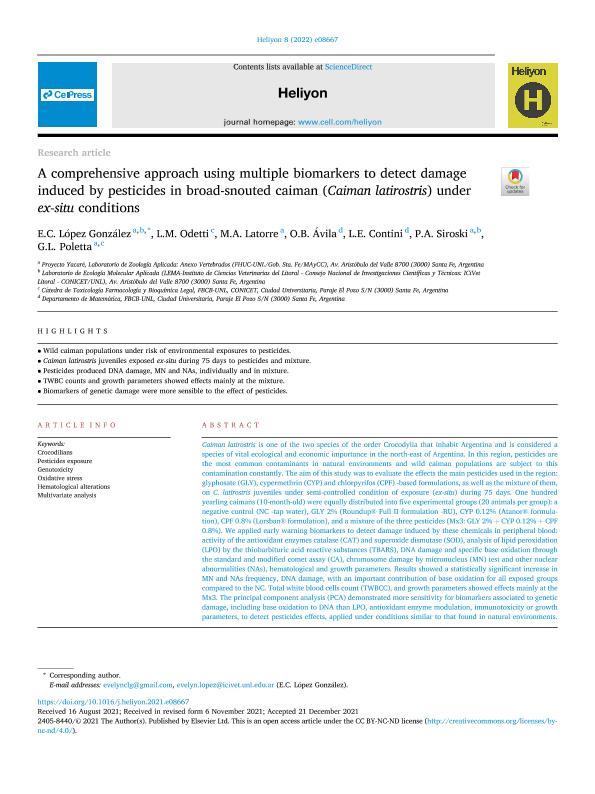Artículo
A comprehensive approach using multiple biomarkers to detect damage induced by pesticides in broad-snouted caiman (Caiman latirostris) under ex-situ conditions
López González, Evelyn Cecilia ; Odetti, Lucia Magdalena
; Odetti, Lucia Magdalena ; Latorre, María Agustina
; Latorre, María Agustina ; Ávila, Olga B.; Contini, Liliana Ester; Siroski, Pablo Ariel
; Ávila, Olga B.; Contini, Liliana Ester; Siroski, Pablo Ariel ; Poletta, Gisela Laura
; Poletta, Gisela Laura
 ; Odetti, Lucia Magdalena
; Odetti, Lucia Magdalena ; Latorre, María Agustina
; Latorre, María Agustina ; Ávila, Olga B.; Contini, Liliana Ester; Siroski, Pablo Ariel
; Ávila, Olga B.; Contini, Liliana Ester; Siroski, Pablo Ariel ; Poletta, Gisela Laura
; Poletta, Gisela Laura
Fecha de publicación:
01/2022
Editorial:
Elsevier
Revista:
Heliyon
ISSN:
2405-8440
Idioma:
Inglés
Tipo de recurso:
Artículo publicado
Clasificación temática:
Resumen
Caiman latirostris is one of the two species of the order Crocodylia that inhabit Argentina and is considered a species of vital ecological and economic importance in the north-east of Argentina. In this region, pesticides are the most common contaminants in natural environments and wild caiman populations are subject to this contamination constantly. The aim of this study was to evaluate the effects the main pesticides used in the region: glyphosate (GLY), cypermethrin (CYP) and chlorpyrifos (CPF) -based formulations, as well as the mixture of them, on C. latirostris juveniles under semi-controlled condition of exposure (ex-situ) during 75 days. One hundred yearling caimans (10-month-old) were equally distributed into five experimental groups (20 animals per group): a negative control (NC -tap water), GLY 2% (Roundup® Full II formulation -RU), CYP 0.12% (Atanor® formulation), CPF 0.8% (Lorsban® formulation), and a mixture of the three pesticides (Mx3: GLY 2% + CYP 0.12% + CPF 0.8%). We applied early warning biomarkers to detect damage induced by these chemicals in peripheral blood: activity of the antioxidant enzymes catalase (CAT) and superoxide dismutase (SOD), analysis of lipid peroxidation (LPO) by the thiobarbituric acid reactive substances (TBARS), DNA damage and specific base oxidation through the standard and modified comet assay (CA), chromosome damage by micronucleus (MN) test and other nuclear abnormalities (NAs), hematological and growth parameters. Results showed a statistically significant increase in MN and NAs frequency, DNA damage, with an important contribution of base oxidation for all exposed groups compared to the NC. Total white blood cells count (TWBCC), and growth parameters showed effects mainly at the Mx3. The principal component analysis (PCA) demonstrated more sensitivity for biomarkers associated to genetic damage, including base oxidation to DNA than LPO, antioxidant enzyme modulation, immunotoxicity or growth parameters, to detect pesticides effects, applied under conditions similar to that found in natural environments.
Archivos asociados
Licencia
Identificadores
Colecciones
Articulos(CCT - SANTA FE)
Articulos de CTRO.CIENTIFICO TECNOL.CONICET - SANTA FE
Articulos de CTRO.CIENTIFICO TECNOL.CONICET - SANTA FE
Articulos(ICIVET-LITORAL)
Articulos de INST. DE CIENCIAS VETERINARIAS DEL LITORAL
Articulos de INST. DE CIENCIAS VETERINARIAS DEL LITORAL
Citación
López González, Evelyn Cecilia; Odetti, Lucia Magdalena; Latorre, María Agustina; Ávila, Olga B.; Contini, Liliana Ester; et al.; A comprehensive approach using multiple biomarkers to detect damage induced by pesticides in broad-snouted caiman (Caiman latirostris) under ex-situ conditions; Elsevier; Heliyon; 8; 1; 1-2022; 1-11
Compartir
Altmétricas



